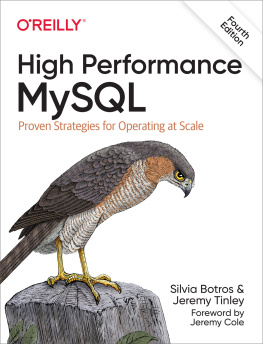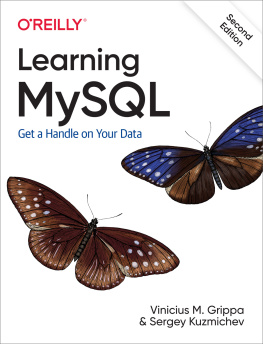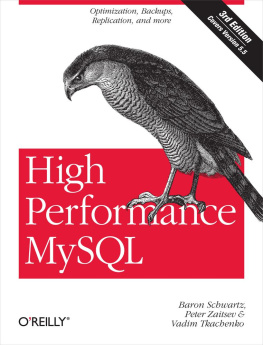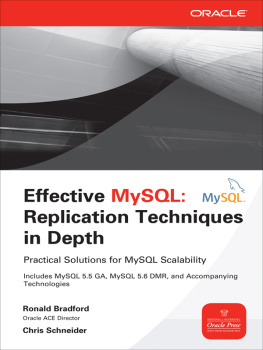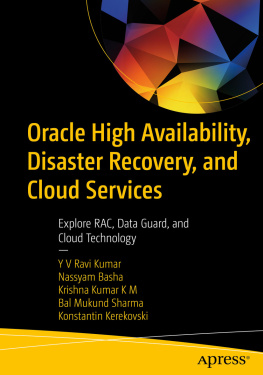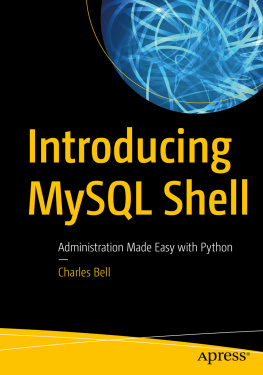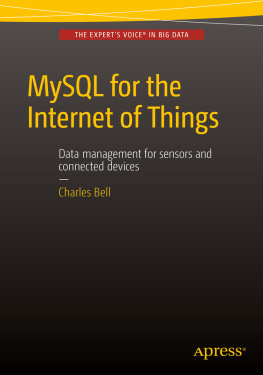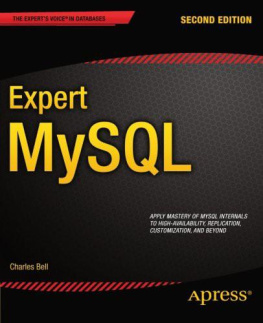MySQL High Availability
Charles Bell
Mats Kindahl
Lars Thalmann
Copyright 2010 Charles Bell, Mats Kindahl, and Lars Thalmann
OReilly books may be purchased for educational, business, or sales promotional use. Online editions are also available for most titles (.
Nutshell Handbook, the Nutshell Handbook logo, and the OReilly logo are registered trademarks of OReilly Media, Inc. MySQL High Availability , the image of an American robin, and related trade dress are trademarks of OReilly Media, Inc.
Many of the designations used by manufacturers and sellers to distinguish their products are claimed as trademarks. Where those designations appear in this book, and OReilly Media, Inc., was aware of a trademark claim, the designations have been printed in caps or initial caps.
While every precaution has been taken in the preparation of this book, the publisher and authors assume no responsibility for errors or omissions, or for damages resulting from the use of the information contained herein.

O'Reilly Media
A lot of research has been done on replication, but most of the resulting concepts are never put into production. In contrast, MySQL replication is widely deployed but has never been adequately explained. This book changes that. Things are explained here that were previously limited to people willing to read a lot of source code and spend a lot of time debugging it in production, including a few late-night sessions.
Replication enables you to provide highly available data services while enduring the inevitable failures. There are an amazing number of ways for things to fail, including the loss of a disk, server, or data center. Even when hardware is perfect or fully redundant, people are not. Database tables will be dropped by mistake. Applications will write incorrect data. Occasional failure is assured. But with reasonable preparation, recovery from failure can also be assured. The keys to survival are redundancy and backups. Replication in MySQL supports both.
But MySQL replication is not limited to supporting failure recovery. It is frequently used to support read scale-out. MySQL can efficiently replicate to a large number of servers. For applications that are read-mostly, this is a cost-effective strategy for supporting a large number of queries on commodity hardware.
And there are other interesting uses for MySQL replication. Online DDL is a very complex feature to implement in an relational database management system. MySQL does not support online DDL, but through the use of replication you can implement something that is frequently good enough. You can get a lot done with replication if you are willing to be creative.
Replication is one of the features that made MySQL wildly popular. It is also the feature that allows you to convert a popular MySQL prototype into a successful business-critical deployment. Like most of MySQL, replication favors simplicity and ease of use. As a consequence, it is occasionally less than perfect when running in production. This book explains what you need to know to successfully use MySQL replication. It will help you to understand how replication has been implemented, what can go wrong, how to prevent problems, and how to fix them when they crop up despite your best attempts at prevention.
MySQL replication is also a work in progress. Change, like failure, is also assured. MySQL is responding to that change and replication continues to get more efficient, more robust, and more interesting. For instance, row-based replication is new in MySQL 5.1.
While MySQL deployments come in all shapes and sizes, I care most about data services for Internet applications and am excited about the potential to replicate from MySQL to distributed storage systems like HBase and Hadoop. This will make MySQL better at sharing the data center.
I have been on teams that support important MySQL deployments at Facebook and Google. I have had the opportunity, problems, and time to learn much of what is covered in this book. The authors of this book are also experts on MySQL replication, and by reading this book you can share their expertise.
Preface
The authors of this book have been creating parts of MySQL and working with it for many years. Charles Bell is a senior developer working on replication and backup. His interests include all things MySQL, database theory, software engineering, and agile development practices. Dr. Mats Kindahl is the lead developer for replication and a member of the MySQL Backup and Replication team. He is the main architect and implementor of the MySQL row-based replication and has also developed the unit testing framework used by MySQL. Dr. Lars Thalmann is the development manager and technical lead of the MySQL Replication and Backup team and has designed many of the replication and backup features. He has worked with development of MySQL clustering, replication, and backup technologies.
We wrote this book to fill a gap we noticed among the many books on MySQL. There are many excellent books on MySQL, but few that concentrate on its advanced features and its applications, such as high availability, reliability, and maintainability. In this book, you will find all of these topics and more.
We also wanted to make the reading a bit more interesting by including a running narrative about a MySQL professional who encounters common requests made by his boss. In the narrative, you will meet Joel Thomas, who recently decided to take a job working for a company that has just started using MySQL. You will observe Joel as he learns his way around MySQL and tackles some of the toughest problems facing MySQL professionals. We hope you find this aspect of the book entertaining.
Audience
This book is for MySQL professionals. We expect you to have a basic background in SQL, administering MySQL, and the operating system you are running. We will try to fill in background information about replication, disaster recovery, system monitoring, and other key topics of high availability. See for other books that offer useful background.
Organization of This Book
This book is written in three parts. examines some additional areas of MySQL, including cloud computing and MySQL clusters.
, explains how this book can help you and gives you a context for reading it.
, discusses both manual and automated procedures for setting up basic replication.
, explains the critical file that ties together replication and helps in disaster recovery, troubleshooting, and other administrative tasks.
, shows a number of ways to recover from server failure, including the use of automated scripts.
, shows a number of techniques and topologies for improving response time and handling large data sets.
, addresses a number of topics, such as secure data transfer and row-based replication.
, presents the main operating system parameters you have to be aware of, and tools for monitoring them.
, presents several tools for monitoring database activity and performance.
, explains some of the parameters you need to monitor on a more detailed level, focusing on issues specific to MyISAM or InnoDB.
, offers details about how to keep track of what masters and slaves are doing.
, shows how to deal with failures and restarts, corruption, and other incidents.


